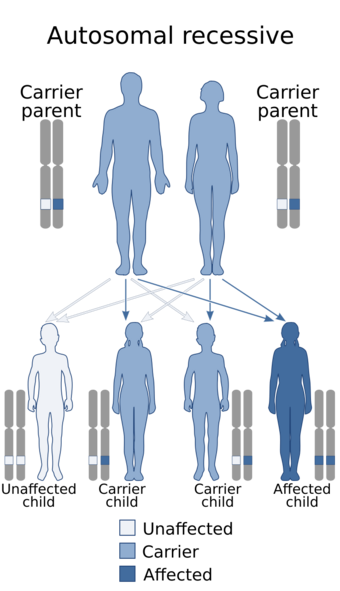Medicine:DeSanctis–Cacchione syndrome
From HandWiki
| DeSanctis–Cacchione syndrome | |
|---|---|
| Other names | Xeroderma pigmentosum with neurologic manifestation[1] |
 | |
| DeSanctis–Cacchione syndrome is inherited in an autosomal recessive manner | |
DeSanctis–Cacchione syndrome is a genetic disorder characterized by the skin and eye symptoms of xeroderma pigmentosum (XP) occurring in association with microcephaly, progressive intellectual disability, slowed growth and sexual development, deafness, choreoathetosis, ataxia and quadriparesis.[2]
Genetics
In at least some case, the gene lesion involves a mutation in the CSB gene.[3]
It can be associated with ERCC6.[4]
Diagnosis
Treatment
See also
- Xeroderma pigmentosum
- List of cutaneous conditions
References
- ↑ RESERVED, INSERM US14-- ALL RIGHTS. "Orphanet: De Sanctis Cacchione syndrome" (in en). https://www.orpha.net/consor/cgi-bin/OC_Exp.php?lng=en&Expert=1569.
- ↑ Rapini, Ronald P.; Bolognia, Jean L.; Jorizzo, Joseph L. (2007). Dermatology: 2-Volume Set. St. Louis: Mosby. ISBN 978-1-4160-2999-1.
- ↑ Colella, S.; Nardo, T.; Botta, E.; Lehmann, A. R.; Stefanini, M. (2000). "Identical mutations in the CSB gene associated with either Cockayne syndrome or the de Sanctis-Cacchione variant of xeroderma pigmentosum". Human Molecular Genetics 9 (8): 1171–1175. doi:10.1093/hmg/9.8.1171. PMID 10767341.
- ↑ "Identical mutations in the CSB gene associated with either Cockayne syndrome or the DeSanctis-cacchione variant of xeroderma pigmentosum". Hum. Mol. Genet. 9 (8): 1171–5. May 2000. doi:10.1093/hmg/9.8.1171. PMID 10767341.
External links
| Classification | |
|---|---|
| External resources |
 |

